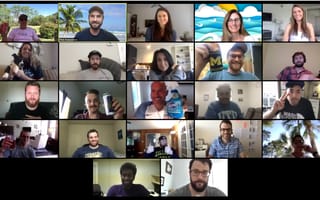Was your day spent being productive or putting out fires? For many tech professionals working remotely right now, workload has increased — rather than decreased — in light of the pandemic. And stress is at an all-time high.
During stressful periods, Monica Matison, director of people at logistics and supply chain company Shipwell, likes to re-evaluate where her focus should be at any given time. She makes a clear distinction between tasks that are urgent and those that are important, asking herself if there is anything she can push to the back burner or delegate.
“It’s OK to move project priorities or let them drop off your plate for the right reasons,” Matison said. “Making sure you are mentally willing to let go of them for that moment in time matters most.”
At Envoy Global, a global immigration services provider, Neetha Sindu controls what she can by letting technology do (some) of the work for her. To prioritize and manage her to-do list, the senior manager uses Microsoft To Do. The cloud-based task management app creates lists based on importance and deadlines.
Sindu, Matison and their colleagues shared their top tips for managing stress while remaining productive during unprecedented times, highlighting their favorite management tools, practices and mindset shifts.

For people operations team members Monica Matison, Madison Little and Kendal Lackey, the health and safety of the Shipwell team is a top priority, especially during uncertain times. With that in mind, the trio said they organize their work based on what will have the greatest impact on employees, followed by more general to-dos.
What is the very first thing you do when your workload increases or you get a new project added to your plate?
Matison: Any time something new comes into the picture, you need to reevaluate your “to-dos” and figure out what is more important. Is there anything you can push to the back burner or delegate?
For example, no one could have planned for the pandemic. For people operations, our one and only priority surrounded the health and safety of our team. Everything else could wait.
It’s OK to move project priorities or let them drop off your plate for the right reasons. Making sure you are mentally willing to let go of them for that moment in time is what matters most.
How do you prioritize and manage your “to-dos” in a way that minimizes stress?
Little: Through lists and time management. The biggest thing for me personally is ensuring that I have everything that I need to accomplish during that day and week written out. I list the tasks that require the greatest urgency first.
For example, if my team is bringing on new hires that week, onboarding those team members becomes a priority. From there, I outline the remaining items that I would like to accomplish by the end of the day or week.
This organizational list becomes my guiding source for the week. Finding what personally works for you is key to being happy and successful within your role.
It’s important to first identify what it means to feel maxed out.’’
How do you know when to ask for help, and what steps do you take to protect your mental health when your workload increases?
Lackey: It’s important to first identify what it means to feel maxed out. When you know how much you can handle without sacrificing quality, you’ll recognize when it’s time to ask for help or speak with your manager. When I have a full workload, I like to prioritize my tasks and then block off time on my calendar to fully focus. I make a note on my Slack status that I’m in a “high-priority task time.” Sometimes I reserve a conference room to eliminate distractions or listen to my favorite music to feel inspired.
My team understands that employees can overwork themselves at home, especially during COVID-19. In response, we have created a social calendar to ensure employees have opportunities to take a break and stay connected.
The social calendar includes practices like monitoring our news intake and writing down what we’re thankful for. We have a “virtual watercooler” active all day through Zoom, which serves as a live video call to replicate office hallway and kitchen chats.
In honor of mental health awareness month, we are promoting meditating throughout the day and participating in yoga during lunch and after work. We are even challenging employees to go for a long walk and track their steps or simply remember to stretch throughout the day. In addition, we offer unlimited PTO to encourage work-life balance, so employees can take time off when they need it.

Corporate Sales Director Woody Salsinger said honing his time management ability is what enables him to remain productive despite a heavy workload. Co-workers Senior Global Mobility Specialist Jim Yang and Senior Manager Neetha Sindhu shared which tools they rely on to streamline their days.
What is the very first thing you do when your workload increases or you get a new project added to your plate?
Yang: I like to use a tool called the Eisenhower Matrix. It helps me categorize tasks by importance, which helps me determine what will bring the most value to the customer and my team. For example, if the project is marked urgent, I’ll see it outlined as a top priority. If it’s not, I’ll know to block off time to get it finished later.
How do you prioritize and manage your “to-dos” in a way that minimizes stress?
Sindhu: I let technology do the work for me. I use Microsoft To Do to tackle my workload. To Do creates and prioritizes lists based on importance and deadline.
When taking on a new project, I like to get a sense of how long it will take to complete right away.’’
How do you know when to ask for help, and what steps do you take to protect your mental health when your workload increases?
Salsinger: It’s all about time management. When taking on a new project, I like to get a sense of how long it will take to complete right away. Then, I’ll block time off on my calendar dedicated to that project and won’t worry about it until that time comes. I also set expectations with the project manager by letting them know when I anticipate completion so they can plan other deadlines accordingly.









